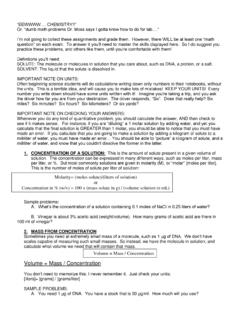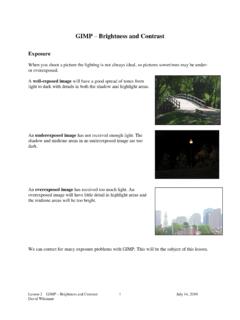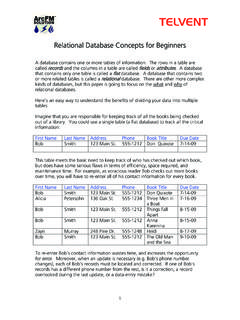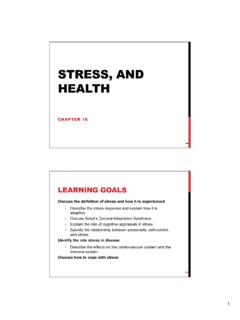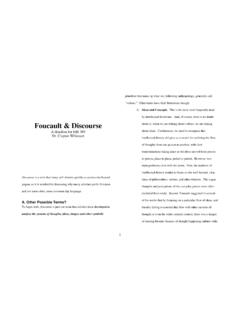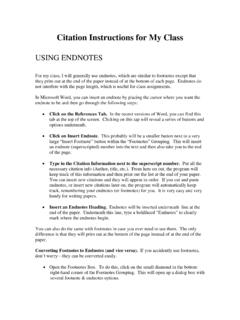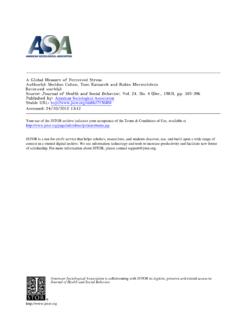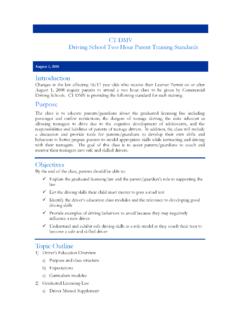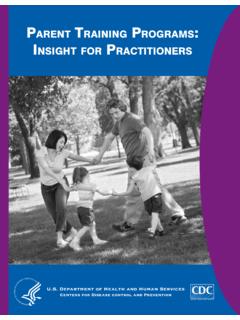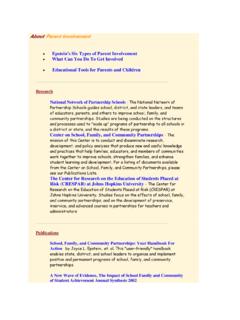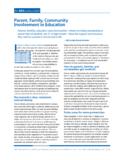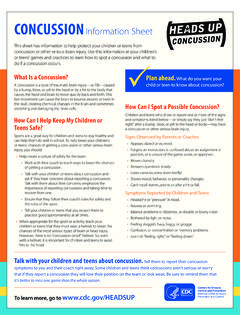Transcription of Cognitive Problem-Solving Skills Training and …
1 Journal of Consulting and Clinical Psychology1992, Vol. 60, No. 5, 733-747 Copyright 1992 by the American Psychological Association, Problem-Solving Skills Training and Parent ManagementTraining in the Treatment of Antisocial Behavior in ChildrenAlan E. KazdinYale UniversityTodd C. Siegel and Debra BassUniversity of Pittsburgh School of MedicineThis study evaluated the effects of Problem-Solving Skills Training (PSST) and parent managementtraining (PMT) on children (JV = 97, ages 7-13 years) referred for severe antisocial behavior. Chil-dren and families were assigned randomly to 1 of 3 conditions: PSST, PMT, or PSST and PMTcombined. It was predicted that (a) each treatment would improve child functioning (reduce overalldeviance and aggressive, antisocial, and delinquent behavior, and increase prosocial competence);and (b) PSST and PMT combined would lead to more marked, pervasive, and durable changes inchild functioning and greater changes in parent functioning (parental stress, depression, and over-all symptoms).
2 Expectations were supported by results at posttreatment and 1 -year follow-up. PSSTand PMT combined led to more marked changes in child and parent functioning and placed agreater proportion of youth within the range of nonclinic (normative) levels of child behavior includes aggressive acts, theft, van-dalism, fire setting, lying, truancy, running away, and other actsthat violate major social rules and expectations. A persistentpattern of antisocial behavior, referred to as conduct disorder,affects diverse domains of current functioning and for manyyouth portends continued dysfunction in adulthood (see Ro-bins, 1981; Rutter & Giller, 1983). Several characteristics under-score the clinical and social significance of conduct prevalence rate is relatively high and encompasses 2 to 6%of school-age children (Institute of Medicine [IOM], 1989).
3 Inthe United States alone, this translates to between and cases. In addition, among children and adolescents,conduct disorder and aggressive and antisocial behaviors en-compass one half to one third of all clinic referrals and lead thelist of dysfunctions seen in clinical practice (see Kazdin, 1987a).Several longitudinal studies indicate that conduct disorder isrelatively stable over time, portends diverse problems in adult-hood ( , criminal behavior, alcoholism, and poor work ad-justment), and often continues across generations (see Pepler &Rubin, 1991; Robins & Rutter, 1990).Among the challenges to treatment is the range of dysfunc-tions that antisocial youth display. In addition to their antiso-cial symptoms, youth often evince hyperactivity, Cognitive defi-cits and distortions, poor peer relations, and academic dysfunc-Completion of this research was supported by a grant (MH35408)and a Research Scientist Award (MH00353) from the National Insti-tute of Mental are grateful to several clinic staff, including Wayne Ayers, Mau-reen Doody, Mary Dulgeroff, Yvonne Engelman, Audrey Hoch, Jen-nifer Mazurick, Antoinette Rodgers, Christopher Thomas, and concerning this article should be addressed to AlanE.
4 Kazdin, Department of Psychology, Yale University, Box 11 AYale Station, New Haven, Connecticut Moreover, parent psychopathology and multiple sourcesof stress ( , socioeconomic disadvantage, marital discord, sin-gle-parent families, and large family size) are commonly asso-ciated with conduct disorder. Diagnostically, conduct disorderis based on symptoms the child presents. Clinically, however,one is often confronted with a "package" involving parent, fam-ily, and socioeconomic factors in which child dysfunction and family characteristics are fundamentally relatedto antisocial child behavior. Parental stress, psychopathology,and social isolation, poor parental relations, and related factorsaffect the onset, escalation, and maintenance of antisocial be-havior (Pepler & Rubin, 1991; Robins & Rutter, 1990). Whileresearch continues to unravel the specific ways in which parentand family influences operate, treatment implications are al-ready evident.
5 For antisocial children, parent dysfunction andfamily adversity predict dropping out of treatment, degree oftherapeutic change among those who remain, and maintenanceof treatment gains among those who change ( , Dumas &Wahler, 1983; Kazdin, 1990; Patterson, 1986; Webster-Stratton,1985). Thus, added and related to the task of reducing antisocialchild behavior is the need to contend with parent and familyissues that materially affect treatment process and scope of dysfunction in children, parents, and familiesmakes conduct disorder a haven for diverse conceptual ap-proaches to treatment. Central constructs from different thera-peutic approaches ( , poorly developed superego, cognitivedeficits, behavioral excesses, poor parenting Skills , and unto-ward family dynamics) can be readily applied to conduct disor-dered children and can serve as a reasonable warrant for treat-ment selection.
6 However, few treatments have actually docu-mented change with clinically referred antisocial youth (seeBrandt & Zlotnick, 1988; Kazdin, 1985). Among the availabletreatments, cognitively based Problem-Solving Skills Training (PSST) and parent management Training (PMT) are particu-733734A. KAZDIN, T. SIEGEL, AND D. BASS larly promising. Each approach has a conceptual model relatingspecific processes to disruptive and antisocial behavior, re-search evaluating these processes, and outcome evidence show-ing change with disruptive children (for reviews, see Dumas,1989; Kazdin, 1987b; Kendall, 1991; Miller & Prinz, 1990). Forthese treatments, however, evidence is still far from specific role of central concepts ( , various Cognitive pro-cesses and parenting practices) in generating and sustainingantisocial behavior, the connection between model-specificprocesses and therapeutic change, and the integration of influ-ences outside of the specific models raise significant based treatment and parent Training have reducedaggression and antisocial child behavior at home and at schoolin several studies, noted in the reviews cited above.
7 Here, too,however, fundamental questions remain. Treatment effects arenot always replicated; treatment often leaves children with de-viant behavior above the range of normative levels; and gainsachieved with treatment are not invariably maintained. Clearly,the need remains for more reliable, potent, and durable thera-peutic interventions for antisocial , the search for effective interventions beginswith evaluation of a specific treatment directed toward salientfeatures of antisocial child behavior. Yet, given the scope ofdysfunction, combinations of treatments that address interre-lated domains warrant special attention in maximizing thera-peutic change (IOM, 1989). There are a number of reasonsPSST and PMT might be worth combining. To begin with, thetreatments are conceptually complementary. PSST focuses onthe individual child and the Cognitive -behavioral repertoires heor she brings to diverse interpersonal situations; PMT focuseson child-rearing practices, parent-child interactions, and con-tingencies that can support prosocial behavior at home and atschool.
8 The concurrent focus on Cognitive processes of thechild, parent-child interaction, and external contingencies tosupport prosocial child behavior might act in concert and sur-pass the impact of either PSST or PMT reason for combining these treatments pertains tothe potential impact on parent and family functioning. Parentsof conduct disordered children engage in inept child-rearingpractices and interaction patterns that sustain and escalatechild dysfunction ( , Patterson, 1986; Patterson, Capaldi, &Bank, 1991). A child-focused treatment, even if effective, mayleave unaddressed parenting practicesand interactions that con-tribute to child dysfunction. Maternal stress, depression, andrelated symptoms contribute to these interactions and in a recip-rocal way are likely to be exacerbated by them ( , Dumas &Gibson, 1990; Patterson, 1986).
9 Occasionally, PMT has beenshown to reduce parental stress and symptoms of dysfunction(Kazdin, 1985; Miller & Prinz, 1990). Thus, a parent-basedcomponent of treatment might not only augment change in thechild but also affect parent and family domains on which im-provement and maintenance partially present study evaluated three treatments, namely, PSST,PMT, and their combination (PSST + PMT). Previous researchhas indicated that PSST and PMT as separate treatments canlead to therapeutic change. Because of their combined and com-plementary foci, we expected PSST + PMT to lead to moremarked, pervasive, and durable changes in antisocial behaviorand other areas of child functioning than either constituenttreatment alone. We also expected that PSST + PMT woulddecrease maternal stress and symptoms of dysfunction and im-prove family characteristics.
10 The participants consisted of 97 children (21girls and 76 boys) referred for treatment to a psychiatric facility thatprovides services for children, adolescents, and adults. Children re-ferred for aggressive and antisocial behavior were seen at the ChildConduct Clinic, an outpatient service from which the present partici-pants were drawn. Children were included if (a) they were referred totreatment for fighting, unmanageability at home or at school, stealing,running away, truancy, or related antisocial behaviors; (b) they wererated by their parent or guardian above the 90th percentile on eitherthe aggression or delinquency scale of the Child Behavior Checklist(CBCL; Achenbach & Edelbrock, 1983); (c) they were 7 to 13 years ofage; (d) they read at or above the second grade level on the Wide RangeAchievement Test (WRAT; Jastak & Jastak, 1978); (e) they showed noevidence of neurological impairment, uncontrolled seizures, or de-mentia; (f) were not receiving psychotropic medication; and (g) bothchild and parent (or guardian) provided consent.
